What are the big questions facing Gary O’Neil and Wolves ahead of the 2024-25 Premier League season?
Hopes were not high for Wolves when Julen Lopetegui walked out on the eve of the 2023-24 season, following months of grumbling about the club’s transfer policy.
However, his replacement Gary O’Neil overachieved spectacularly through the first two thirds of his debut campaign, only for it to end with a sense of what might have been, with injuries to Matheus Cunha, Pedro Neto and Hwang Hee-chan derailing an unlikely European charge.
With O’Neil having a full pre-season with his squad this time around, hopes are high that 2024-25 could bring progress. There are several questions to answer, though, particularly after the big-money sales of Max Kilman and Pedro Neto.
Who Can Replace Pedro Neto?
Neto’s departure is the best place to start after Wolves sanctioned his club-record sale to Chelsea, receiving £51.4 million plus bonuses for the jet-heeled winger.
Having arrived at Molineux a talented yet raw teenager in 2019, Neto leaves as one of the Premier League’s top creative forces, albeit one too often stunted by fitness concerns.
Last season, Neto laid on nine assists in just 20 Premier League appearances totalling 1,518 minutes. Among all players in the competition to play at least 1,500 minutes, Neto averaged the most assists per 90, with 0.42. Of the 11 players to tee up more goals for teammates, only Kevin De Bruyne – who supplied a frankly ludicrous 10 in 1,227 minutes – spent less time on the pitch than Neto.
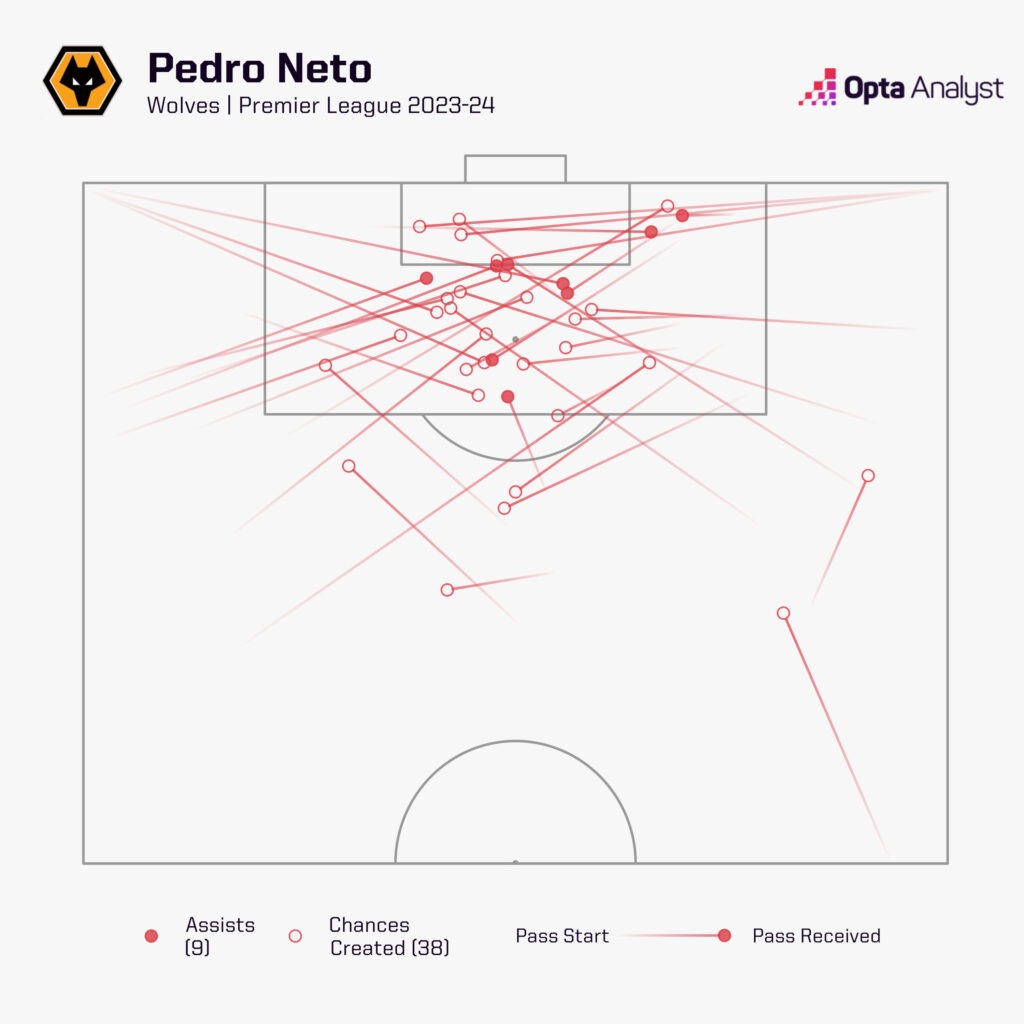
Two hamstring injuries – suffered when in full flow versus Newcastle United in October and Fulham in March – cut Neto’s finest campaign at Molineux short, and Wolves frankly had no choice but to accept such a huge offer for a player who has played at most 20 league games in each of the last three seasons.
Keeping him fit is now Chelsea’s concern, with Wolves’ focus on replacing his output.
With Neto only tallying 3.7 expected assists (xA) last season, it could be argued that he benefitted from some excellent finishing from teammates, and Wolves did overperform their underlying attacking metrics as a team in 2023-24, scoring 50 goals from 47.6 expected goals (xG).
Giving greater freedom to Cunha (more on him later) and Pablo Sarabia, who managed seven assists in 1,748 minutes, could make up for the loss of Neto, and it should be said that Wolves only won one league game fewer without Neto starting (six) than they did with him in their lineup last term (seven).
Sarabia could be set for a more prominent role, having spent pre-season playing as a number 10 in a new-look 4-2-3-1 system. A look at Opta’s Player Radars shows how closely Sarabia’s creative output mirrors that of Neto, with the Spaniard ranking in the 94th percentile among wingers in the top five European leagues for chances created. Sarabia also outdoes Neto for shots and xG, but he is not a dynamic ball-carrier.
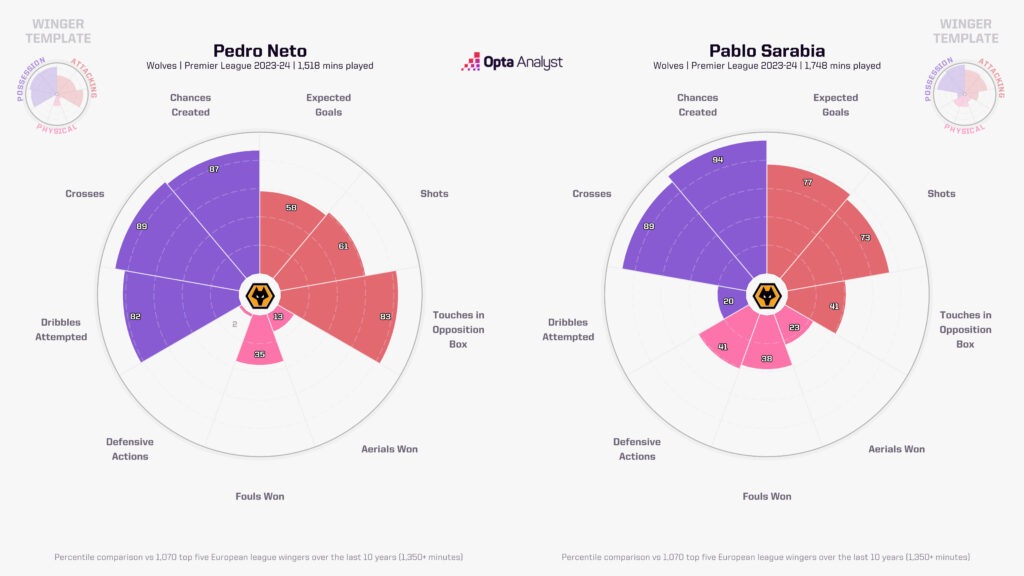
Indeed, only two Premier League players – Chiedozie Ogbene (15.1 metres) and Anthony Elanga (14.54) – travelled further per ball carry than Neto (14.53) last season, and his ability to drag Wolves upfield was particularly crucial against elite opponents. For those in need of video evidence, look up his lung-busting run to force a Rúben Dias own goal in a 2-1 victory over Manchester City, or his assist for João Gomes’ winner at Tottenham.
Fortunately for O’Neil, he may not need to turn to the transfer market to replace that aspect of Neto’s game…
How Far Can Matheus Cunha Go?
Ranking fourth for average carry distance among all Premier League players in 2023-24? That would be Cunha, who also averaged more progress upfield (10.0 metres) per carry than Neto (9.0m).
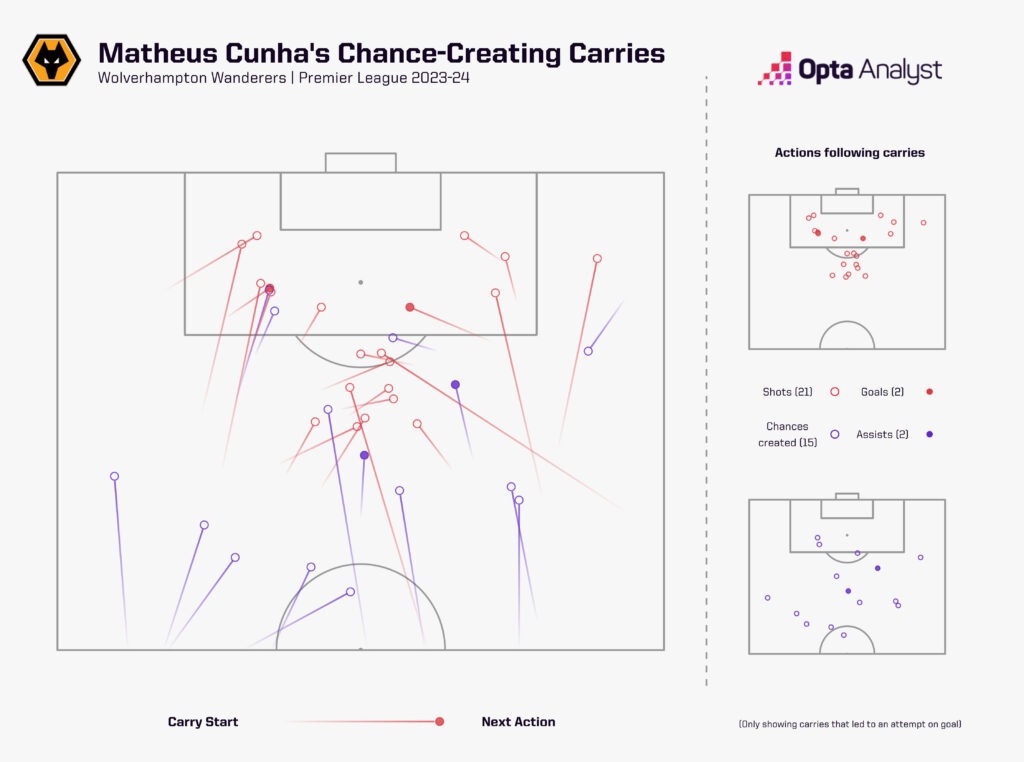
Cunha initially struggled when brought in on loan by Lopetegui in the second half of 2022-23, but the Brazil international has relished the way O’Neil gives his attackers freedom to improvise and rotate. His total of 19 goal involvements in 2023-24 (12 goals, seven assists) was the third highest by a Wolves player in any Premier League season, after Raúl Jiménez in 2019-20 (23) and 2018-19 (20).
Like Neto, Cunha saw his season stunted by injury at a crucial point, missing six league games (and a chastening FA Cup quarter-final loss to Coventry City) due to a hamstring problem he sustained in February.
Of all the injury blows Wolves suffered last term, Cunha’s was arguably the most telling, with Wolves averaging 1.5 goals per league game when the Brazilian started and just 0.8 without him.
Whether fielded on the left or behind the striker, Cunha plays a vital, all-round role in Wolves’ offensive efforts, recording more attacking sequence involvements (116) than any of his teammates last season despite his advanced position and the fact he was limited to 2,453 Premier League minutes.
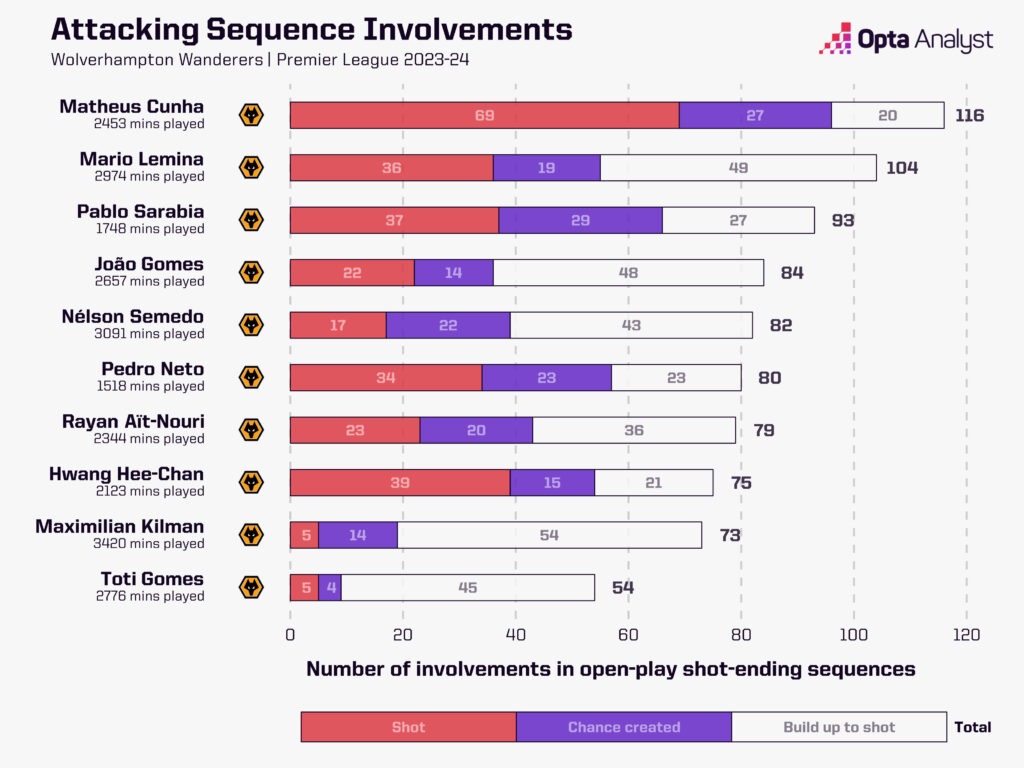
Cunha was tentatively linked with a move to Manchester United this summer, and perhaps the only barrier to concrete interest in him is the huge fee (£42.8m) Wolves paid to acquire him from Atlético Madrid in the first place.
Ahead of kick-off against Brentford on February 10, when Cunha suffered his hamstring injury, Wolves sat 10th in the Premier League table, six points adrift of sixth-placed Man Utd and one ahead of Chelsea, who eventually finished 17 clear of O’Neil’s men.
Had Cunha stayed fit, who knows how close Wolves may have been to European qualification? If he remains injury-free in 2024-25, expect impressive numbers and heads turned among the top six.
Will ‘Gazball’ Become More Defined?
It seems a long time ago, but O’Neil struggled to win fans over at the outset of his reign, with an early League Cup exit to Ipswich Town prompting fierce criticism last September.
However, Wolves then immediately kick-started their campaign by beating Man City, and a comeback victory over his former employers Bournemouth three weeks later provided further vindication for O’Neil.
After that 2-1 win on the south coast, O’Neil made a memorable appearance on Sky Sports’ Monday Night Football programme, winning admirers as he dissected those victories and explained his coaching philosophy.
Showing training clips to demonstrate how Wolves beat Andoni Iraola’s press and describing the lopsided defensive shape that kept City star Erling Haaland to 0.06 xG, O’Neil gained a reputation as a detail-oriented coach prepared to tailor his approach to the opponent.
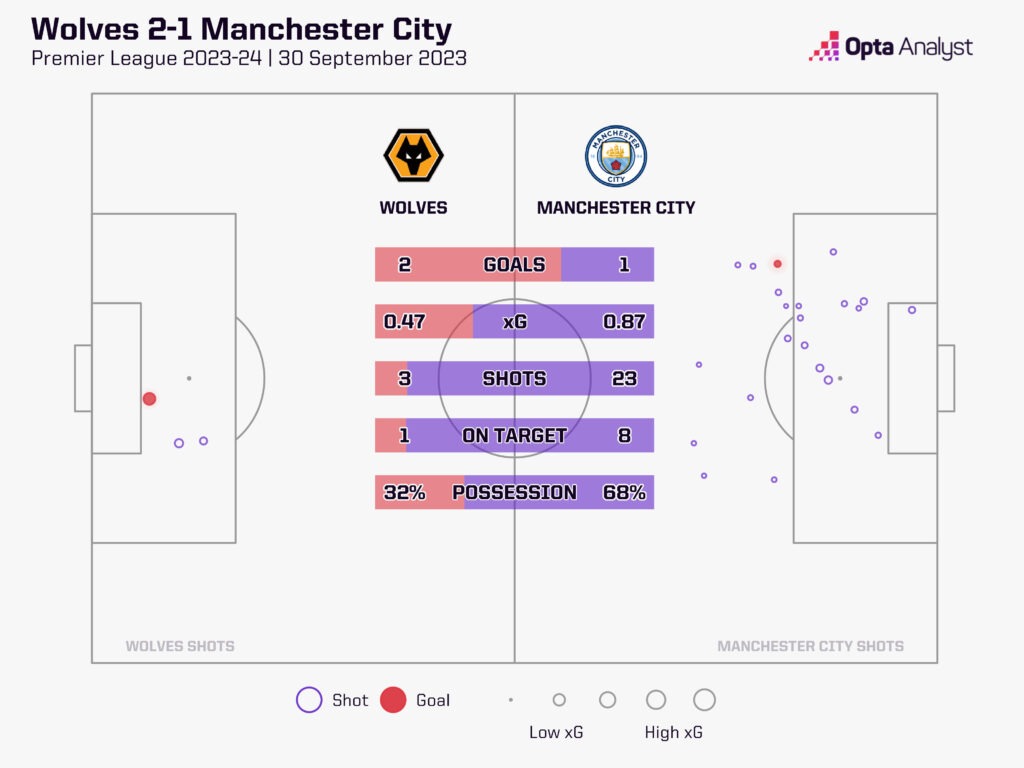
Speaking to Sky Sports about his philosophy last December, O’Neil said: “This is our first thought when we win the ball back; can we score? No? Okay then let’s keep the ball. That is the order.”
While the pace of Cunha, Neto and Hwang led many to depict Wolves as a direct attacking outfit last term, they ultimately ranked 10th in the Premier League for direct attacks, with 65 (defined as an open-play sequence that starts just inside the team’s own half, has at least 50% of its movement towards the opposition’s goal, and ends in a shot or a touch in the opposition box). Wolves were certainly effective when allowed to play on the counter-attack, though, ranking joint-third for shots from counters (36).
Curiously, though, only Man City (1.38 metres per second) and Brighton and Hove Albion (1.56) moved the ball upfield slower than Wolves (1.57) on their average attack. The next two teams by that metric – Vincent Kompany’s Burnley (1.59) and Mikel Arteta’s Arsenal (1.61) – were also clearly influenced by Pep Guardiola’s approach.
Wolves were something of a chameleon in O’Neil’s first season, relishing their opportunities to counter-attack against the league’s elite but dominating the ball against lesser opponents, particularly at Molineux. With a pre-season under his belt, O’Neil will be expected to forge a more consistent tactical identity in 2023-24.
Do not expect O’Neil to stifle his attackers with too much structure, though. Wolves scored 50 Premier League goals last season after hitting 36, 38 and 31, respectively, in their previous three campaigns.
O’Neil’s greatest success has been bringing some joy to Wolves’ attacking play, and that must endure this season. Perhaps a change of shape might help…
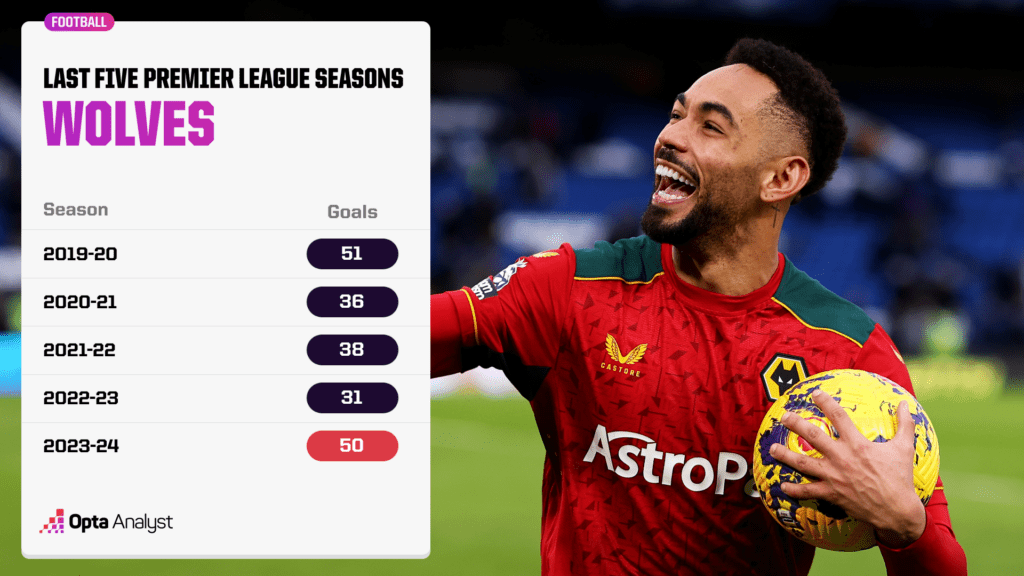
Are the Days of 3-4-3 Over?
“With five at the back, and pace in attack, we’re Wolverhampton, we’re on our way back”, was a familiar refrain among the Molineux masses as Nuno Espírito Santo oversaw back-to-back seventh-place finishes in 2018-19 and 2019-20.
Ever since those halcyon days, Wolves have been synonymous with a 3-4-3 or 3-5-2 shape. Nuno himself attempted to transition to a back four in 2020-21, but successor Bruno Lage – much like O’Neil last term – ditched the experiment when it became clear he lacked centre-backs capable of dominating one-on-one.
Flexibility has been the name of the game for O’Neil, with his 3-4-3 often resembling a 4-4-2 when out of possession as the left wing-back – typically Rayan Aït-Nouri – pushes on with left-sided centre-back Toti Gomes shifting across.
In November’s 2-1 victory over Tottenham – arguably Wolves’ best performance of the campaign – Wolves’ average positions clearly resembled a 3-4-3 shape as they took the game to Ange Postecoglou’s depleted side. But in a Christmas Eve win over Chelsea, when Wolves spent long periods out of possession, they formed a 4-4-2 block and restricted the space available to the Blues in midfield.
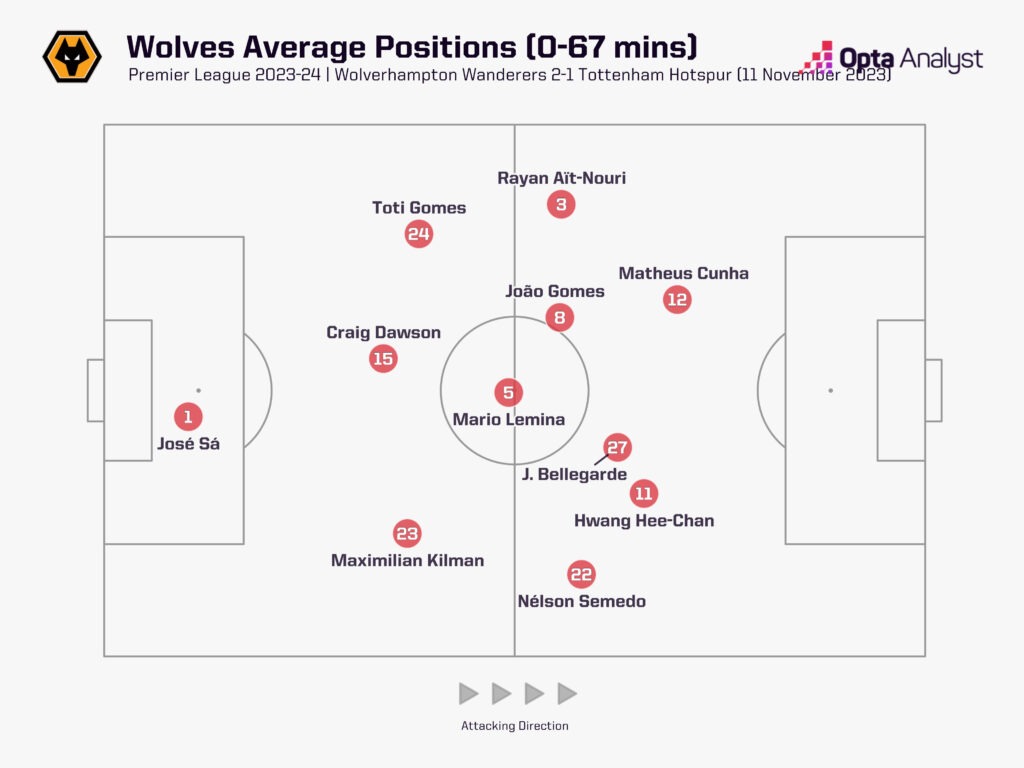
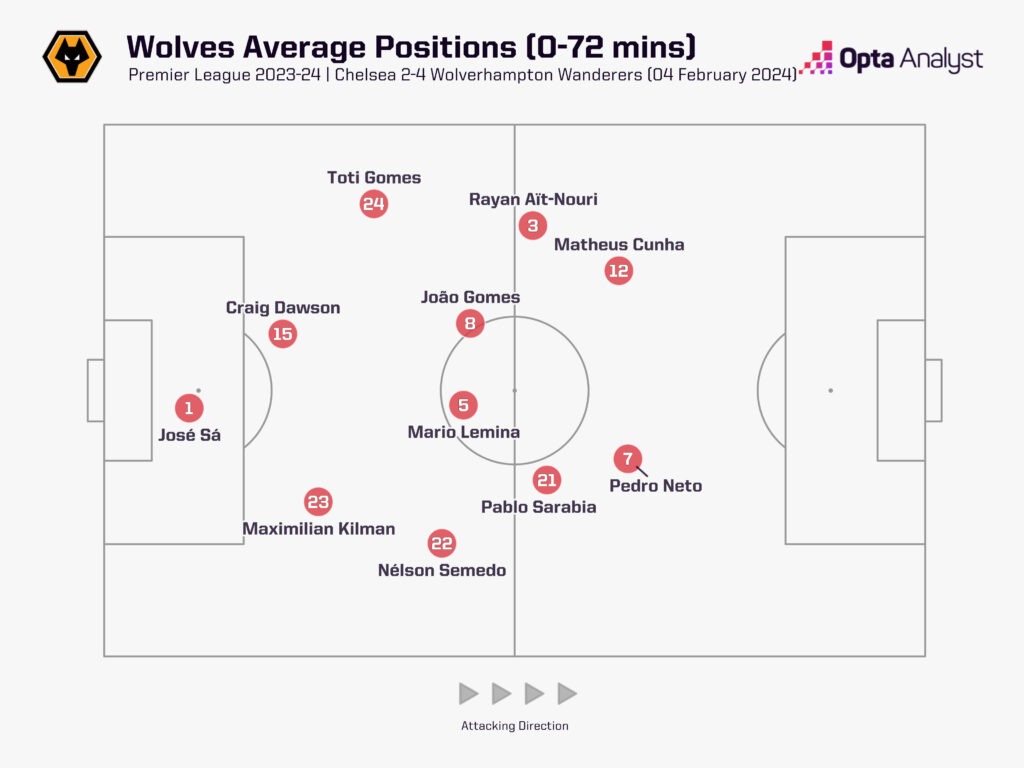
While O’Neil said during pre-season that he wants Wolves’ shape to be “fluid”, he added: “When we can, I’d like for us to only have four defenders on the pitch”. This change of tack, intended to get another talented attacker on the field, may have been made possible by the £40m sale of Kilman to West Ham.
Kilman was one of just two outfielders to play all 3,420 minutes in the Premier League in 2023-24 (alongside Arsenal’s William Saliba). He is a gifted operator in possession, but he was often singled out by supporters for a lack of mobility and tendency to switch off. Only Trent Alexander-Arnold and Destiny Udogie (five apiece) made more errors leading to shots in the Premier League last season (four).
His exit may just offer a chance for evolution, particularly with Neto’s sale easing concerns about compliance with the Premier League’s profit and sustainability rules, with O’Neil pledging to use the funds to strengthen “in a few areas”.
Colombia international Yerson Mosquera has returned after making 16 appearances on loan at Villarreal in 2023-24, and his recovery pace could allow Wolves to remove the safety blanket of a third centre-back.
As Opta’s Player Radars help to show, Mosquera is far more adept than Kilman at winning ground duels, though the fact he also got minutes at right-back for the Yellow Submarine last season likely inflated his ranking in that metric. While raw, the 23-year-old is a proactive, aggressive defender and is expected to get a chance back at Wolves this term.
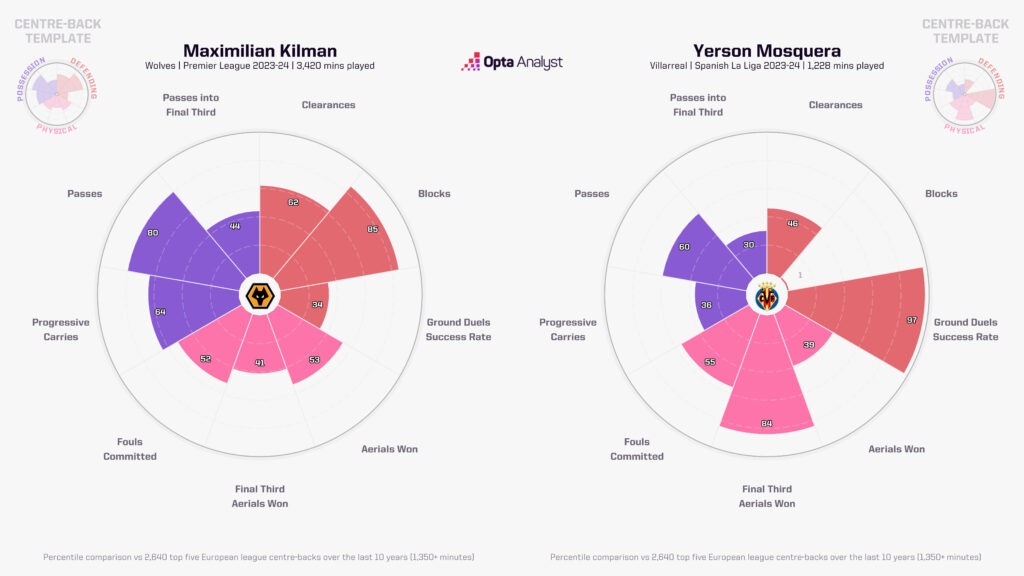
The club might yet still sanction a marquee defensive addition in the closing weeks of the transfer window. That signing could decide the result of Wolves’ latest back-four experiment.
Have Wolves Found the Striker They Need?
Wolves started 2023-24 hoping it might finally be Fábio Silva’s season, four years on from his £35m arrival from Porto, only for the Portuguese striker to fail to net in eight league outings. Six-foot-seven target man Sasa Kalajdzic made his mark with late winners at Everton and Bournemouth, but by February, both players had been jettisoned out on loan.
The fluidity of Wolves’ attack was generally a strength in O’Neil’s first season at the helm, with Cunha (19), Hwang (15), Neto and Sarabia (both 11) all cracking double figures for Premier League goal involvements.
However, as injuries derailed Wolves’ push for Europe in the spring, there was a nagging sense that the failure to add a traditional number nine in January had left them short. Chelsea’s Armando Broja was a deadline-day target, only for financial concerns to prevent Wolves from striking a deal as he was instead loaned to Fulham.
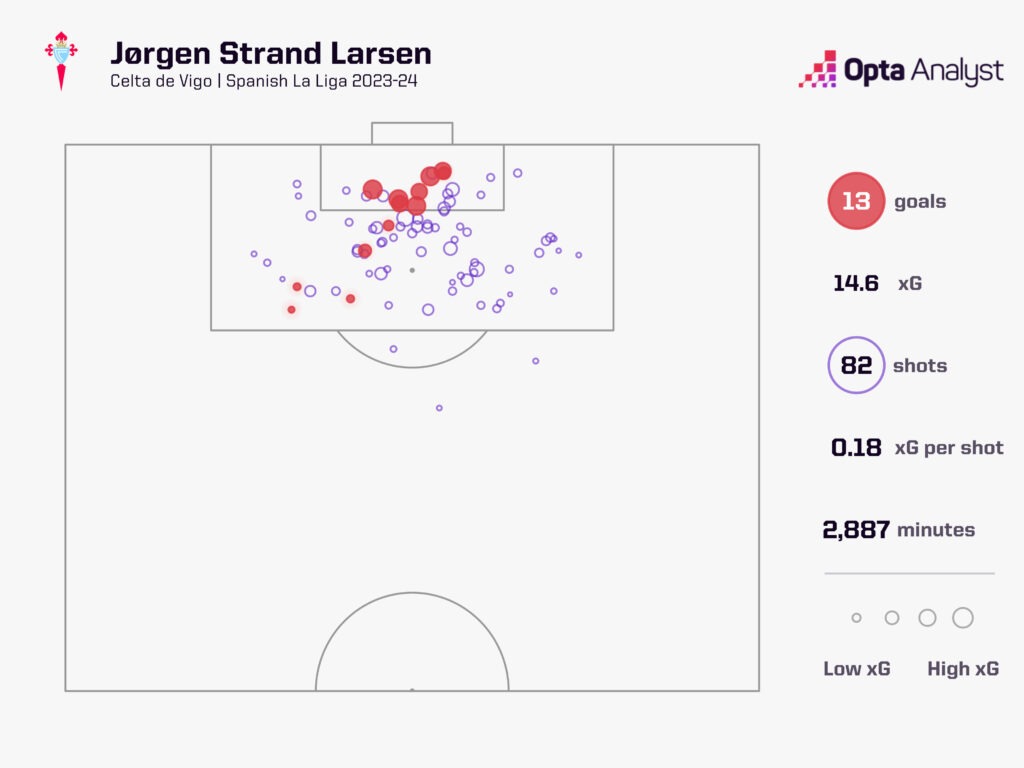
Wolves have looked to avoid a repeat by signing Jørgen Strand Larsen, who has joined on loan from Celta Vigo with a view to a £23m permanent deal. Larsen scored 13 goals in 37 games as Celta pulled clear of danger to finish 13th in La Liga last season. It was his second-most prolific campaign in one of Europe’s top 10 leagues, after scoring 14 Eredivisie goals for Groningen in 2021-22.
The Norway international underperformed his underlying attacking figures in 2023-24, his 13 goals coming from 14.6 xG. Fans should be encouraged by his tendency to pop up in dangerous areas, though, with only Golden Boot winner Artem Dovbyk (24.3) and Barcelona’s Robert Lewandowski (18.1) registering greater xG tallies in La Liga last season.
It will be intriguing to see what Larsen’s arrival means for Hwang, who spent much of 2023-24 as Wolves’ biggest threat, scoring more league goals (12) than in his previous three seasons with Wolves and RB Leipzig combined (none in 2020-21, five in 2021-22 and three in 2022-23).
Only seven Premier League players overperformed their xG figures by a greater margin than Hwang (+4.3) in 2023-24, so perhaps a drop-off is to be expected. But if Larsen can be the focal point Wolves have missed, the South Korean could cause damage marauding inside from the right, as well as bringing discipline and energy out of possession.
With Daniel Podence and Gonçalo Guedes also back from loan spells and featuring in pre-season, Wolves’ attacking depth is suddenly better than it has been for some time. If O’Neil gets the balance right, a comfortable improvement on 14th could be within Wolves’ grasp.
Enjoy this? Subscribe to our football newsletter to receive exclusive weekly content. You should also follow our social accounts over on X, Instagram, TikTok and Facebook.
